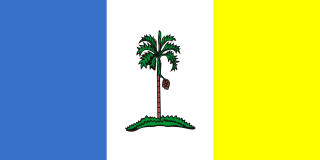
The afghani is the currency of the Islamic Republic of Afghanistan, which is issued by the nation's central bank called Da Afghanistan Bank. It is nominally subdivided into 100 puls (پول), although there are no pul coins currently in circulation. In 2019, one U.S. dollar was exchanged for approximately 75 afghanis.

Rupee is the common name for the currencies of India, Pakistan, Indonesia, the Maldives, Mauritius, Nepal, Seychelles, and Sri Lanka, and of former currencies of Afghanistan, Tibet, Burma, British East Africa, German East Africa, the Trucial States, and all Gulf Arab Countries.

The rupee is the currency of the Seychelles. It is subdivided into 100 cents. In the local Seychellois Creole (Seselwa) language, it is called the roupi. The international currency code is SCR. The abbreviations SR and SRe are sometimes used. Seychelles is the smallest country to have an independent monetary policy. Several other currencies are also called rupee.

The Indian Rupee is the official currency of India. The rupee is subdivided into 100 paise, though as of 2018, coins of denomination of 50 paise or half rupee is the lowest value in use. The issuance of the currency is controlled by the Reserve Bank of India. The Reserve Bank manages currency in India and derives its role in currency management on the basis of the Reserve Bank of India Act, 1934.
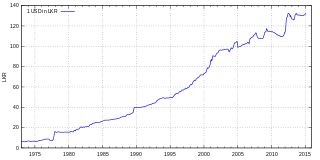
The rupee is the currency of Sri Lanka, divided into 100 cents. It is issued by the Central Bank of Sri Lanka. The abbreviation is generally Rs., but "LKR" is occasionally used to distinguish it from other currencies also called rupee.

The Pakistani Rupee (Urdu: روپیہ / ALA-LC: Rūpiyah; sign: ₨; code: PKR; is the official currency of Pakistan. The issuance of the currency is controlled by the State Bank of Pakistan, the central bank of the country. The most commonly used symbol for the rupee is Rs, used on receipts when purchasing goods and services.
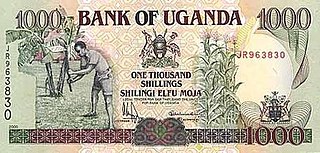
The shilling is the currency of Uganda. Officially divided into cents until 2013, the shilling now has no subdivision.
Coins of the Indian rupee were first minted in 1950. New coins have been produced annually since then and they make up a valuable aspect of the Indian currency system. Today, circulating coins exist in denominations of ₹1, ₹2, ₹5, and ₹10. All of these are produced by four mints located across India, in Kolkata, Mumbai, Hyderabad and Noida.

The dollar has been the currency of Liberia since 1943. It was also the country's currency between 1847 and 1907. It is normally abbreviated with the dollar sign $, or alternatively L$ or LD$ to distinguish it from other dollar-denominated currencies. It is divided into 100 cents.

The dollar (R$) was the currency of Rhodesia between 1970 and 1980. It was subdivided into 100 cents.
In 1820, in response to a request from the British colony of Mauritius, the imperial government in London struck silver coins in the denominations of 1⁄4, 1⁄8, and 1⁄16 dollars. The dollar unit in question was equivalent to the Spanish dollar and these fractional coins were known as 'Anchor Dollars' because of the anchor that appeared on them. More of these anchor dollars were struck in 1822 and not only for Mauritius but also for the British West Indies. In addition to this, a 1⁄2 dollar anchor coin was struck for Mauritius. A year or two later, copper dollar fractions were struck for Mauritius, the British West Indies, and Sierra Leone.
The rupee was the currency of Burma between 1852 and 1952, except for the years 1943–1945.

The Rupie was the currency of German East Africa between 1890 and 1916, continuing to circulate in the Tanganyika Territory until 1920.
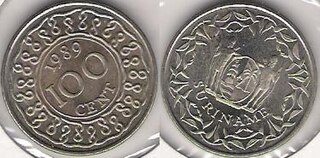
The guilder was the currency of Suriname until 2004, when it was replaced by the Surinamese dollar. It was divided into 100 cents. Until the 1940s, the plural in Dutch was cents, with centen appearing on some early paper money, but after the 1940s the Dutch plural became cent.
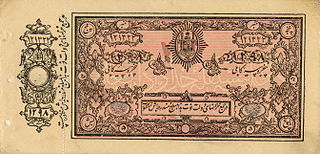
The Afghan rupee was the currency of Afghanistan until 1925. Before 1891, silver rupees circulated with copper falus and gold mohur. The three metals had no fixed exchange rate between them, with different regions issuing their own coins.
The Malayan dollar was the currency of the British colonies and protectorates in Malaya and Brunei until 1953. It was introduced in 1939, replacing the Straits dollar at par, with 1 dollar = two shillings four pence sterling.
The daler was the currency of the Danish West Indies between 1849 and 1917, and of the United States Virgin Islands between 1917 and 1934.
The British North Borneo dollar was the currency of British North Borneo from 1882 to 1953. It was subdivided into 100 cents. The dollar had remained at par with the Straits dollar, the currency of Malaya and Singapore, at the value of one dollar to 2 shillings 4 pence sterling from its introduction until both currencies were replaced by the Malaya and British Borneo dollar in 1953. Both coins and banknotes were issued by the British North Borneo Company.

The dollar was the currency of Sarawak from 1858 to 1953. It was subdivided into 100 cents. The dollar remained at par with the Straits dollar and its successor the Malayan dollar, the currency of Malaya and Singapore, from its introduction until both currencies were replaced by the Malaya and British Borneo dollar in 1953.

The dollar was the currency of the colony and dominion of Newfoundland from 1865 until 1949, when Newfoundland became a province of Canada. It was subdivided into 100 cents.
